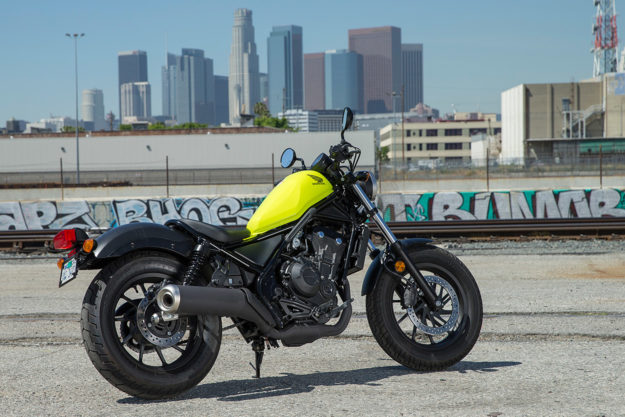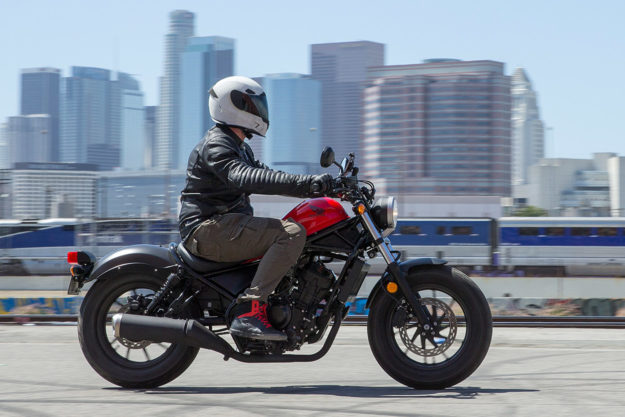
The tractor-style seat provided decent padding and support and I have no doubt it would serve commuters well. But after a full day of battling Angelenos for road real-estate my lower back was starting to bark.
Instrumentation is clean and clear with a single, round digital speedometer. Although I was surprised not to see a tach readout, the fuel gauge was a welcome treat as the slender peanut tank only holds about three gallons of go-go juice.
The front fork angle rests at 30-degrees, with rake and trail set at 28-degrees and 110mm respectively, meaning parking lot maneuvers are a breeze. The Rebel casts a 58.7-inch shadow between contact patches.

The Ride Unlike most bike launches, Honda essentially handed us the keys to the Rebels and told us to go have fun. There was a plotted course we could follow if we wanted, but there’d be no organized parade.
While a part of me wishes I had opted to head towards the twisties of Angeles Crest to scrape some pegs, I decided I’d suffer through urban life on my Rebel. My reasoning was simple: most Rebel buyers are gonna spend more time doing that than apex hunting, so lets suss out how unpleasant that may be. That meant traffic, freeways, traffic and pedestrians. And more traffic.

Luckily for me, Honda opted for a slim profile. The Rebel took to lane splitting like a duck to water and the lower ride height didn’t even hamper my field of view. My ‘morning commute’ aboard the 500 was quick and painless. The grunt from the twin was ample enough to point and squirt in front of everything on four wheels. Merging onto the freeway was a blast and it wasn’t until speeds headed north of 75 mph that the buzz would creep into the bars and seat.
Thanks to the short wheelbase and 16-inch hoops, both flavors of Rebel surrender quickly when approaching a corner. The raised foot pegs offer more lean angle than most cruisers are comfortable with, but I was still able to touch a feeler once or twice during the day.
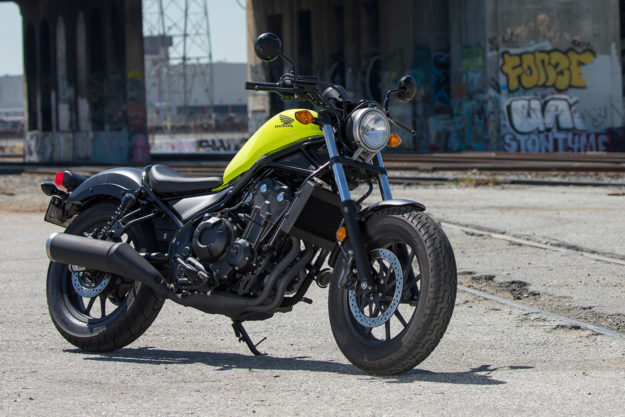
That’s because the chassis is entirely engaging. The stiffness of the frame creates a nimble little machine. My only complaint, really, falls on the Rebels’ suspenders. There’s no adjustment for damping, either front or rear, and the soft set-up had a hard time keeping up with my 200 pounds exploring its limits.
Even after a couple of clicks to the rear pre-load, things still felt a touch bouncy in the corners and the front forks ran out of travel more than once. Things became ‘clangy’ when I found a pothole under braking. And had the Rebel been wearing traditional shoes, I’m sure a bent mag would be getting swapped.
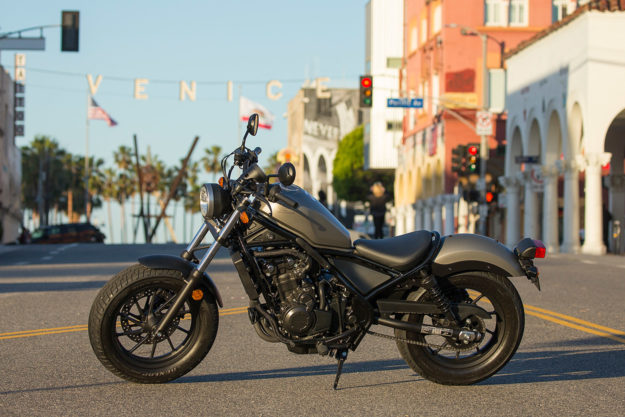
But when building a bike to a budget, as we know, suspension is often where the beans are counted first. It’s also one of the first things most of us look to swap out when looking to customize.
The return trip to the hotel had me working my way through rush hour on the Rebel 300. After being spoiled by the 500’s torque and extra power, the 300 felt a touch anemic. The vibrations from the thumper were also a tad unruly, especially through the seat at higher speeds.
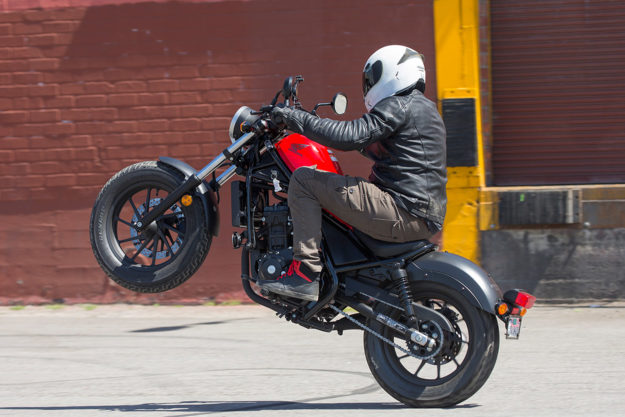
That being said, if freeway travel isn’t a part of your day, the little thumper still has enough puff to get a front wheel aloft if you want—and you won’t suffer on city streets.
It demands a bit more from its rider in terms of pecking and hunting through the gears to get up to and maintain speed, but the added engagement is undeniably fun. If you didn’t know how much more the 500 pulls, you’d never miss it.
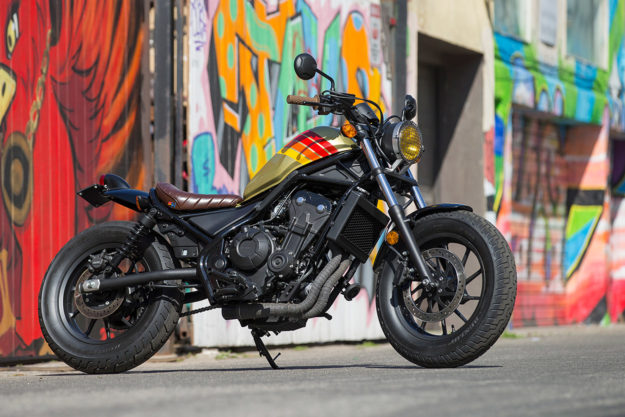
Customizing As we saw when Honda first pulled the wraps off of the new Rebels, the custom market was definitely on their radar during development. The same two one-offs we showed you back then were on hand for us to poke and prod, and a third build (shown above and below) was on display at the Californian fashion shop Aviator Nation.
A common theme amongst them is the disappearance of the rear fender and support struts. This is something I would do immediately were one to find its way into my garage—so I appreciate Honda making that mod a quick and easy affair. A trick LED integration into the rear hoop would finish things off nicely, but would demand some extra work.
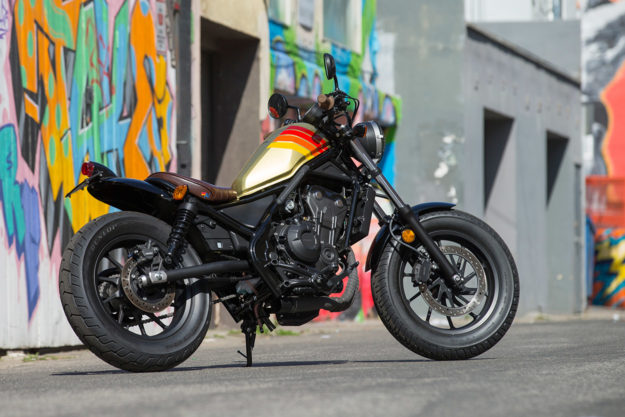
Next up would be an upgrade to the suspension. It’s just too soft to be able to exploit such a nimble chassis, and piggybacks always look the business, anyways.
Outside of these changes, swapping signals for smaller orbs and maybe a new exhaust system, there’s little else I’d touch on either Rebel. It’s truly a well sorted entry level machine.
Of course, we’ve seen what a professional’s hands can do with smaller displacement bikes lately. And I reckon it won’t be long before the new Rebel goes up on somebody’s bench.
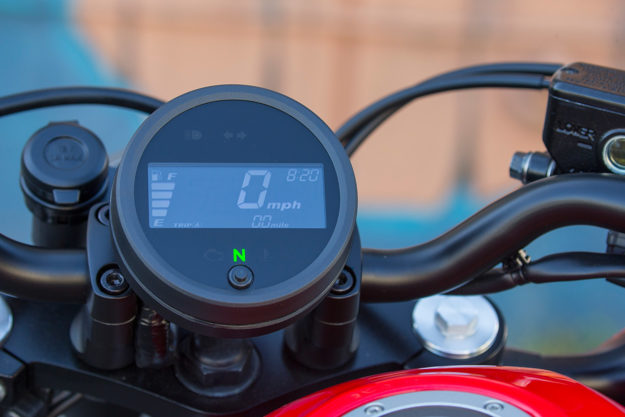
Final Verdict For the first time in a long time, small displacement, entry-level motorcycles have become a point of focus for manufacturers looking to expand markets.
This is good news for everyone: Increased options mean added competition, and that means every OEM wants to make their option the best one. Honda has a long history of doing it right, and the changes to the Rebel have made an aging but good bike better in every possible way.
Honda Rebel product page | Facebook | US pricing: Rebel 300 $4,399 to $4,699 (ABS), Rebel 500 $5,999 to $6,299 (ABS) | Images by Kevin Wing
Matt’s Gear Helmet: Icon Airframe Pro Jacket: Spidi Metal Pants: UglyBros Motorpool Boots: Alpinestars J-8 Gloves: Racer Gloves Mickeys | Look for a full Gear Review, coming soon.
